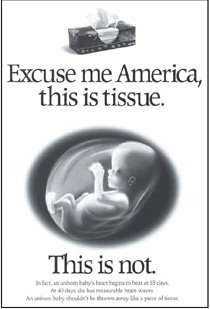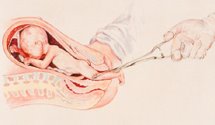Online Catholic News Daily Contributes to Pro-Lifers’ Confusion over Use of Graphic Abortion Images

In an article published online yesterday by California Catholic Daily, and sparked by the recent high profile news about Ross Foti and his “abortion truck,” Christopher Zehnder offers his thoughts on the use of graphic images in public settings.
Instead this apologetic for excluding graphic images from the public domain was a dismal failure and only contributed to more confused thinking by many self proclaimed “pro-lifers.” The article appears below with my comments in brackets and colour. If readers can help to fine tune my thoughts or to correct me where I’m wrong, your comments are welcome. Much more previous commentary on this subject can be found on this blog but it is recommended the reader at least read the posting here.
I left comments at California Catholic Daily after reading the article but there's a limit on the number of words you can post so I had to try condensing my thoughts into two comments.
**********
An aborted baby's head -- some thoughts
By Christopher Zehnder
In any cause in which there is agreement on a common goal, the question of means often divides. This is true in the fight against abortion. Everyone may agree on the desired goal – saving unborn children from the abortionist’s knife – but all do not agree on how to accomplish this. The disagreement concerning means may touch on big issues; for instance, whether we should be trying to save children by changing laws or, abandoning the legal path, focus on means that will encourage and enable expectant mothers to decide to bring their babies to term. [Right away, Zehnder shows a very poor grasp of the strategic options. It could be just thoughtlessness and a poor combination of words by the writer but the subject matter simply can’t tolerate confusion. Where is the editor of this paper? The very suggestion of “abandoning the legal path” is incredible! I don’t know any serious pro-lifer who advocates such an approach in favour of a strategy to “encourage and enable expectant mothers to decide to bring their babies to term.” Abortion is the willful destruction of an innocent human life. That’s murder, plain and simple and the Catholic Church, of which I presume Zehnder is a part, clearly says so. What human being then—particularly a pro-lifer—would not seek first and foremost to make such an evil illegal?] Disagreement, however, can hover around smaller issues. And often these smaller issues are more divisive than the larger ones.
The recent controversy at St. Matthew’s parish in San Mateo over whether Mr. Ross Foti should cover or uncover his truck signs displaying pictures of aborted babies when parked adjacent to church property is, perhaps, an example of a disagreement over a small means that can lead to a big rupture. I do not want to get into the particulars of this case, which California Catholic Daily covered on Oct. 1 and 2. [Vote
I purposely leave behind, here, the question of whether the public display of such pictures is effective; for the effectiveness of an action does not necessarily justify it. I think Catholics agree (at least, they should) that a good result does not justify the use of unjust or immoral means -- that one may not do an objectively immoral act even for a very good end. [So Zehnder won’t look at the subject of effectiveness of these images because presumably their use crosses the line into unjust and immoral means. I can understand that approach if Zehnder is now readying his readers for the making of such a case, but simply alluding to the possibility does not make the case. As we shall see, he never does get around to dealing with this question. Why then raise it at all? Whether he realizes it or not, I believe it is an unethical way to get his readers on side.]
I purposely, too, narrow the question even further, [fair enough, but as I said previously, why raise the previous issue at all if that’s not the one he seeks to address?] for the controversy over displaying pictures of aborted children seems to center, not on any display of such pictures, but the their public display -- on city streets, for instance. In other words, one may approve of the use of such pictures in certain contexts while opposing their display in places where anyone walking by can see them. [Maybe I’m missing something but what kind of word gymnastics are going on here? Is Zehnder talking about public displays or not? Isn’t a public display precisely that—a “display in places where anyone walking by can see them?” I wish he would be clearer but I can only presume that he means a public place that’s not so public that you can have the unsuspecting public walk by. If so, what “public place” could ever really qualify? Every “public place,” by virtue of being “public” holds the possibility of the public walking by.]
I confess, I fall in the camp of those who disapprove of the public display of images of dead, saline-burnt, or dismembered corpses of babies -- or of similar images of anyone else, for that matter. [Perhaps if Zehnder had a loved one hacked to pieces or burned to death at a stake and could get no justice he might change his mind about which camp he falls in. This needs to be said in order to provide context!] I admit I have no idea that so displaying such pictures is effective or not; I suspect it may be effective for some, but for others, not only ineffective, but downright counterproductive. [Ok, Zehnder is admitting that he has “no idea” of the effectiveness of these pictures but then immediately goes on to claim they may be ineffective and counterproductive. Thanks for the opinion—yet again, Mr. Zehnder—but why not do a little homework first and try to add clarity to the issue?] Basically, I don’t think such pictures should be displayed publicly because there are certain things that most of us not only need not, but should not, see. And among these things are images of mutilated human corpses. [Great argument: “Don’t show the pictures because we don’t need to see them.” But isn’t that the question to start with? Do we need to see them? Using Zehnder’s argument, we’d never see the “mutilated human corpses” of the Holocaust, the dangling corpses of Blacks lynched, the slashed bodies of the Rwandan genocide, or the dead emaciated bodies of starved children in sub-Saharan
Now, I’m not particularly squeamish. I don’t faint at the sight of blood. It doesn’t even sicken me. This past summer, I had the unique experience of slaughtering about 30 chickens; I didn’t find great satisfaction in the massacre, but I wasn’t particularly repulsed by it, either. It had to be done and I did it. I would do it again. I’ve never had any horror of viewing dead human bodies, either. I’m pretty stoic about such matters. [Except, Mr. Zehnder, we’re not talking about ordinary dead human bodies, are we? We are talking the mangled mutilated bodies of the most innocent of the human race, and we are talking about MURDER. The killing of chickens is not a massacre—the murder of Unborns truly is a massacre and more! Your effort to interject humour here is grossly misplaced.]
However, I don’t like to think of human beings as a bundle of organs or limbs – which is one reason why the study of medicine never attracted me. [And which is one reason outraged pro-lifers show the graphic pictures!] I’m quite content, even happy, that our internal organs are hidden. [As are the evil men and women who sustain the murder of the Unborn.] I think that, for most of us, it’s best that they remain hidden. [Put your head back in the sand then.]
The human body is a beautiful, even poetic, thing. It is a unity, and only when seen as a unity is it seen for what it truly is: the instrument of the soul. [Which is again the main reason grieved Christians protest the dismemberment of human beings using graphic pictures so that the human bodies of unborns may be preserved alive and intact.] The heart may be a blood pump, but that is hardly all it is. It is the corporeal seat of human emotion – whether of love or hate, joy or sorrow. The brain may be the generator of electrical charges, governing bodily functions, yet, it is far more than this. It is the instrument of the immaterial human intellect by which we understand the world, envision ideals, and know God, as far as He can be known in this life. [Is this Catholic philosophy and how is this related to the subject at hand? Sorry, it escaped me and possibly other pro-lifers who are looking for practical help.]
Seeing the body as so many parts tends to reduce man to one component of his being – his animality. It may, indeed, show us that we are rather complex animals, but it cannot show us that we are more than animals. [Again, I missed the point. The goal of graphic images of aborted children is to show the truth of abortion—that innocent unborn children are being violently killed in the womb. There are already laws protecting animals from such treatment. When are we going to get similar laws for humans?] We can understand the eye as an organ of sight by isolating it; but we cannot comprehend it as the window of the soul. Anyone who has seen in the eyes of his beloved that peculiar light that is the expression of love, or has trembled at the glance of hate in the eyes of his enemy, knows whereof I speak. [The Unborn have not experienced such marvellous things because entire societies wish not to be reminded that evil men and women are killing them before they see the light of day.]
Most of us, I think, should withdraw our gaze from images of the body that detract from its unity. [As though injustice did not exist in this world?] This is especially true of gruesome depictions of corpses – torn, dismembered, disemboweled, scarred or burnt. Children, especially, should be shielded from such images, for children, who are developing the impressions of the world that lead to understanding, need to be schooled in beauty. They, in particular, learn to understand what man is by seeing men, and they need to understand, first and foremost, that man is not primarily an animal, but a divine creature enfleshed. [I will restrain myself from commenting in depth on this touchy-feely bit of pie-in-the-sky nonsense, but suffice it to say that children “learn to understand what man is” not so much from simply “seeing man” but by learning of the good—and evil—of which man is capable. And parents are entrusted with the responsibility of interpreting those expressions to them. The sight of a graphic picture on the sidewalk is a perfect parental opportunity for a lesson to the child of the evil of which man is capable and a lesson in devoting our lives to the justice that God demands of us. In addition, such exposure in a public place can hardly be said to rob a child of the “beauty” of life, let alone “destroy the innocence” of the child. Such claims are way over the top under normal circumstances and even hypocritical considering what many of these same parents will allow their children to see on TV, the internet or other books and magazines, to say nothing of the perverted things to which they are exposed in the schools chosen by parents.]
The display of baby corpses, especially when they are gruesome, may, perhaps, help some to understand the horror that is abortion. [It is good to finally get a concession to this fact. Thank you.] They may combat lethargy in the souls of some or, even, many. [Again, a very good point and a large concession. It would have been nice to start out by presenting that perspective.] The public display of such images, however, is analogous to indiscriminate warfare. They subject everyone to a kind of violence; they take in not only those who may deserve such violent jarrings of the spirit but those whose spirits are not prepared for such assaults. They do not distinguish the innocent from the guilty. [Perhaps if we were talking about the effects of graphic pictures in fighting the tobacco industry these might be legitimate arguments, but considering that we are talking about a holocaust of enormous proportions in our land—and one sanctioned by the State—the stakes for justice are enormously higher. Also, considering that there is not one of us—man, woman or child—in this democratic society who is not complicit in the day to day evil which destroys little babies, none of us, at any time ought to be immune from reminders of the horrors we are sponsoring. In this democracy we the people form the structures of government and we cannot escape the fact that the very day we rise up in number to eradicate this evil is the same day little children will be protected from the slaughter. Why should we ask to be exempt from the reminders that come with the graphic pictures? To my way of thinking, this has its healthy aspects. It’s like a smoker’s cough, isn’t it? We certainly don’t deserve it but let’s pray God gives us the time and repentance necessary before the evil kills us.]
And, speaking of effects, do we better teach people about the sanctity of human life through images of degraded human bodies, by bodies reduced to grotesque horror, or by human beauty? [There is a serious confusion and jumbling here between the subjects of sanctity of human life and the justice of God. The use of graphic images in the public arena is perhaps the most effective method and very best balance possible to communicate those two concepts together in one single message. If any pro-lifer can find a better way of combining these two elements we would have a new powerful weapon in our battle. Zehnder’s solution is to ignore one of these concepts altogether.] The reality of man is seen in the nobility of his beauty. [The reality of man is also seen in his evil works. It is convenient for us to forget that.] It may well be that by such tactics as displaying images of aborted babies, especially in a public setting, we may be furthering the very “culture of death” we are trying to combat. [I strongly disagree with such a conclusion. Zehnder certainly has not made a successful argument at all for such a conclusion.]
It is a point, I think, well worth considering.
Labels: abortion commentary, graphic images, pro-life strategy


























0 Comments:
Post a Comment
<< Home